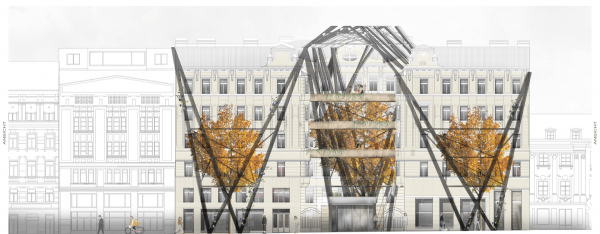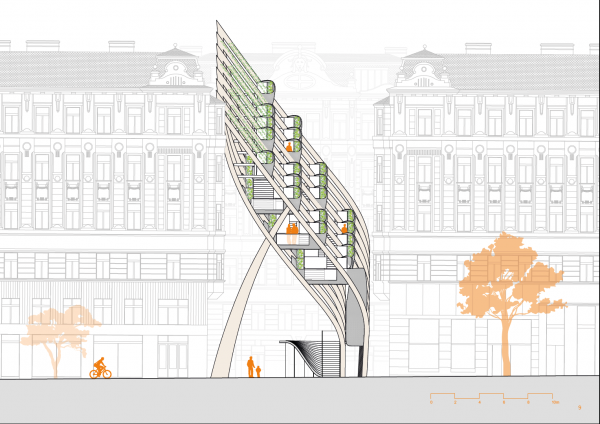Smart & Urban Tree - Exploring integrative possibilities of structures for urban shading
Short Description
Status
Ongoing
Starting point / motivation
Cities all over the globe are currently challenged by climate change and urban heat island effects. Thus, many urban agglomerations started initiatives to reduce the UHI-effect, such as traffic reductions and bans, implementation of blue-and green infrastructures and active and passive cooling and shading devices.
The integration of large-scale greenery to cities regularly is considered as the most feasible option in view of reducing summer overheating and protecting city dwellers from heat waves and connected negative impacts. However, the planting of trees is not necessarily possible everywhere in the city canvas, and the same is true for façade-greening.
This can be due to shortcomings in place, conflicts with other city functionalities, legal and ownership issues or simply due to complexity. For instance, city parts with subway tunnels under surface might not have the substrate volume required for larger trees.
Parallel to the need for shading and cooling, the number of "functionalities" expected in public street space has increased in recent years: In addition to lounging areas and socio-cultural meeting places, traffic areas and charging stations for electric mobility are required, as well as ubiquitous availability of data-intensive WiFi and 5G reception.
The content of this project is located in this interesting field to the extent that a constructional / structural alternative is to be offered for difficult inner-city locations, which is nevertheless capable of fulfilling a large part of the functionalities mentioned.
Contents and goals
The present research project will in-depth study large scale structures for urban shading. Thereby, different aspects that come with such urban interventions, will be considered: the requirements regarding the impact of the structures in the desired domains must be balanced out with the potential design space that is defined by urban/architectural aspects and organizational, administrative, technical and legal constraints.
Based on a virtual case study in the City of Vienna (a city street currently affected by the building site of a new metro line), the domains of construction, function, and impact assessment via modelling and simulation will be worked upon. These efforts will allow to derive recommendations for large-scale urban shading systems with multi-purpose functionality.
Methods
As a first step, data regarding the virtual test site will be collected and prepared for further use in the project, and international examples will be in-depth studied and compared to the planned venture. At the same time, the basic requirements and outcomes awaited of the Smart and Urban Tree structure will be acquired.
This will be done via stakeholder interviews and feasibility studies from different point of views. Subsequently, the necessary boundaries and challenges concerning technical, organizational and domain-specific aspects of a construction and implementation into the city canvas are defined.
These first methodical steps lead to in-depth work in the domains of construction, functions, and modelling and simulation of impact with suitable tools. In the domain of construction all aspects pertaining to building planning and delivery as well as material, structural system, construction methodology, stability and building physics are worked on; these parameters flow into corresponding architectural designs for the smart and urban tree. Questions regarding kinematically variable structures are also considered.
With regard to function, aspects of active and passive cooling, shading, integration of greenery, and added benefit functions, such as generation of socio-cultural spaces on street level will be considered and mapped on the architectural design.
Via state-of-the art modelling and simulation instruments, the efficiency and effectiveness of envisioned designs will be proven. Moreover, the impact on adjacent buildings, the public space on the street and different occupants will be evaluated, e.g., regarding daylight availability.
Expected results
The project Smart and Urban Tree is an exploratory project that examines the potential of artificial, large-scale structures in view of urban heat island mitigation.
The expected results encompass a portfolio of realization ideas and concepts as well as a SWOT-analysis of different design decisions. Moreover, a convolute of visualizations, construction drafts, and simulation results will be accompanied by a feasibility study that considers the acceptance of such structures by city dwellers.
The results of the project will be made available to the general public and will be presented to peers in the different domains via periodicals and conference presentations.
Project Partners
Project management
Senior Scientist DI. Dr.techn. Ulrich Pont - TU Wien, Institute of Architectural Sciences Research - Unit Building Physics and Building Ecology (E259.3)
Project or cooperation partners
- Univ.Prof. DI. Peter Bauer - TU Wien, Research Unit of Structural Design and Timber Engineering (E259.2)
- Senior Lecturer DI. Sigrun Swoboda - TU Wien, Research Unit Digital Architecture and Planning (E259.1)
- DI Peter Schober, Holzforschung Austria / Austrian Forest Products Research Society
Contact Address
TU Wien
Institute of Architectural Sciences
E259.3 Research Unit Building Physics and Building Ecology
Senior Scientist Dipl.Ing. Dr.techn. Ulrich Pont
Karlsplatz 13 / 4
A-1040 Wien
Tel.: +43 (1) 58801 27033
E-mail: ulrich.pont@tuwien.ac.at
Web: www.bpi.tuwien.ac.at


